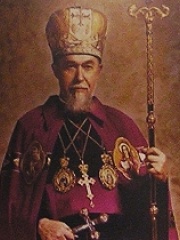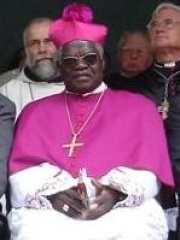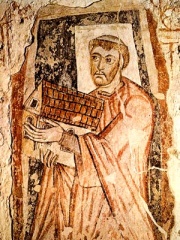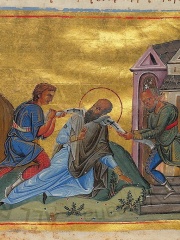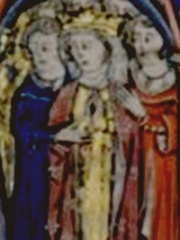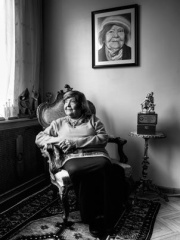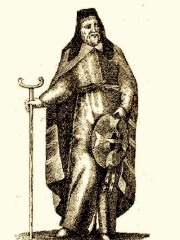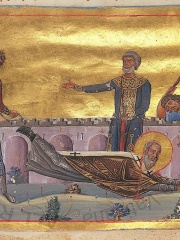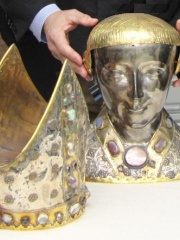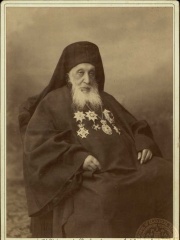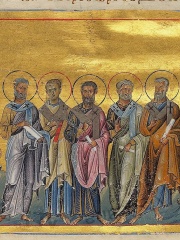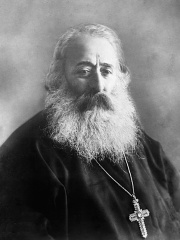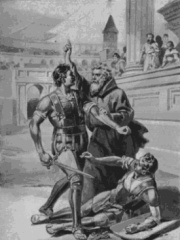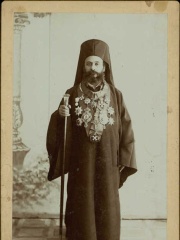RELIGIOUS FIGURE
Victor and Corona
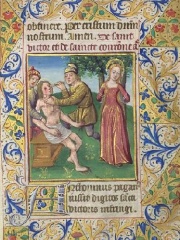
 Victor and Corona
Victor and Corona
Saints Victor and Corona (also known as Saints Victor and Stephanie) are two Christian martyrs. Victor was a Roman soldier who was tortured and killed; Corona was killed for comforting him. Read more on Wikipedia
Since 2007, the English Wikipedia page of Victor and Corona has received more than 494,040 page views. Their biography is available in 15 different languages on Wikipedia. Victor and Corona is the 1,906th most popular religious figure, the 868th most popular biography from Turkey and the 122nd most popular Turkish Religious Figure.
Memorability Metrics
490k
Page Views (PV)
50.96
Historical Popularity Index (HPI)
15
Languages Editions (L)
6.06
Effective Languages (L*)
1.84
Coefficient of Variation (CV)
Page views of Victor and Coronas by language
Among RELIGIOUS FIGURES
Among religious figures, Victor and Corona ranks 1,906 out of 2,238. Before them are Gamzat-bek, Myroslav Ivan Lubachivsky, Jean du Vergier de Hauranne, Kurt Koch, Karl Leisner, and Laurent Monsengwo Pasinya. After them are Yisrael Meir Kagan, Jaime Lucas Ortega y Alamino, Benedict Biscop, Paul I of Constantinople, Georg Gänswein, and Francisco Javier Errázuriz Ossa.
Most Popular Religious Figures in Wikipedia
Go to all Rankings
Gamzat-bek
1789 - 1834
HPI: 51.01
Rank: 1,900
Myroslav Ivan Lubachivsky
1914 - 2000
HPI: 51.01
Rank: 1,901
Jean du Vergier de Hauranne
1581 - 1643
HPI: 51.00
Rank: 1,902
Kurt Koch
1950 - Present
HPI: 51.00
Rank: 1,903
Karl Leisner
1915 - 1945
HPI: 50.99
Rank: 1,904
Laurent Monsengwo Pasinya
1939 - 2021
HPI: 50.98
Rank: 1,905
Victor and Corona
HPI: 50.96
Rank: 1,906
Yisrael Meir Kagan
1838 - 1933
HPI: 50.96
Rank: 1,907
Jaime Lucas Ortega y Alamino
1936 - 2019
HPI: 50.96
Rank: 1,908
Benedict Biscop
628 - 690
HPI: 50.94
Rank: 1,909
Paul I of Constantinople
HPI: 50.94
Rank: 1,910
Georg Gänswein
1956 - Present
HPI: 50.93
Rank: 1,911
Francisco Javier Errázuriz Ossa
1933 - Present
HPI: 50.93
Rank: 1,912

In Turkey
Among people born in Turkey, Victor and Corona ranks 868 out of 1,301. Before them are Ruben Sevak (1885), Arctinus of Miletus (-800), Theodora Komnene, Queen of Jerusalem (1145), Zülfü Livaneli (1946), Özcan Deniz (1972), and Iaia (-100). After them are Mehmed Said Pasha (1830), Muazzez İlmiye Çığ (1914), John XI of Constantinople (1225), Cüneyt Çakır (1976), Hande Yener (1973), and Selahattin Ülkümen (1914).
Others born in Turkey
Go to all Rankings
Ruben Sevak
1885 - 1915
HPI: 51.02
Rank: 862
Arctinus of Miletus
800 BC - Present
HPI: 51.01
Rank: 863
Theodora Komnene, Queen of Jerusalem
1145 - 1180
HPI: 51.00
Rank: 864
Zülfü Livaneli
1946 - Present
HPI: 51.00
Rank: 865
Özcan Deniz
1972 - Present
HPI: 50.98
Rank: 866
Iaia
100 BC - Present
HPI: 50.98
Rank: 867
Victor and Corona
HPI: 50.96
Rank: 868
Mehmed Said Pasha
1830 - 1914
HPI: 50.95
Rank: 869
Muazzez İlmiye Çığ
1914 - Present
HPI: 50.91
Rank: 870
John XI of Constantinople
1225 - 1297
HPI: 50.90
Rank: 871
Cüneyt Çakır
1976 - Present
HPI: 50.90
Rank: 872
Hande Yener
1973 - Present
HPI: 50.89
Rank: 873
Selahattin Ülkümen
1914 - 2003
HPI: 50.85
Rank: 874

Among RELIGIOUS FIGURES In Turkey
Among religious figures born in Turkey, Victor and Corona ranks 122. Before them are Henri Langlois (1914), Eudoxius of Antioch (300), Dorotheus of Tyre (255), Maximus V of Constantinople (1897), Jacob of Nisibis (300), and Sophronius IV of Alexandria (1798). After them are John XI of Constantinople (1225), Onesiphorus (50), Mkrtich Khrimian (1820), Saint Telemachus (301), Basil III of Constantinople (1846), and Serapion of Antioch (200).

Henri Langlois
1914 - 1977
HPI: 51.93
Rank: 116
Eudoxius of Antioch
300 - 370
HPI: 51.89
Rank: 117
Dorotheus of Tyre
255 - 362
HPI: 51.84
Rank: 118
Maximus V of Constantinople
1897 - 1972
HPI: 51.36
Rank: 119
Jacob of Nisibis
300 - 338
HPI: 51.09
Rank: 120
Sophronius IV of Alexandria
1798 - 1899
HPI: 51.07
Rank: 121
Victor and Corona
HPI: 50.96
Rank: 122
John XI of Constantinople
1225 - 1297
HPI: 50.90
Rank: 123
Onesiphorus
50 - Present
HPI: 50.81
Rank: 124
Mkrtich Khrimian
1820 - 1907
HPI: 50.79
Rank: 125
Saint Telemachus
301 - 404
HPI: 50.65
Rank: 126
Basil III of Constantinople
1846 - 1929
HPI: 50.58
Rank: 127
Serapion of Antioch
200 - 212
HPI: 50.55
Rank: 128


